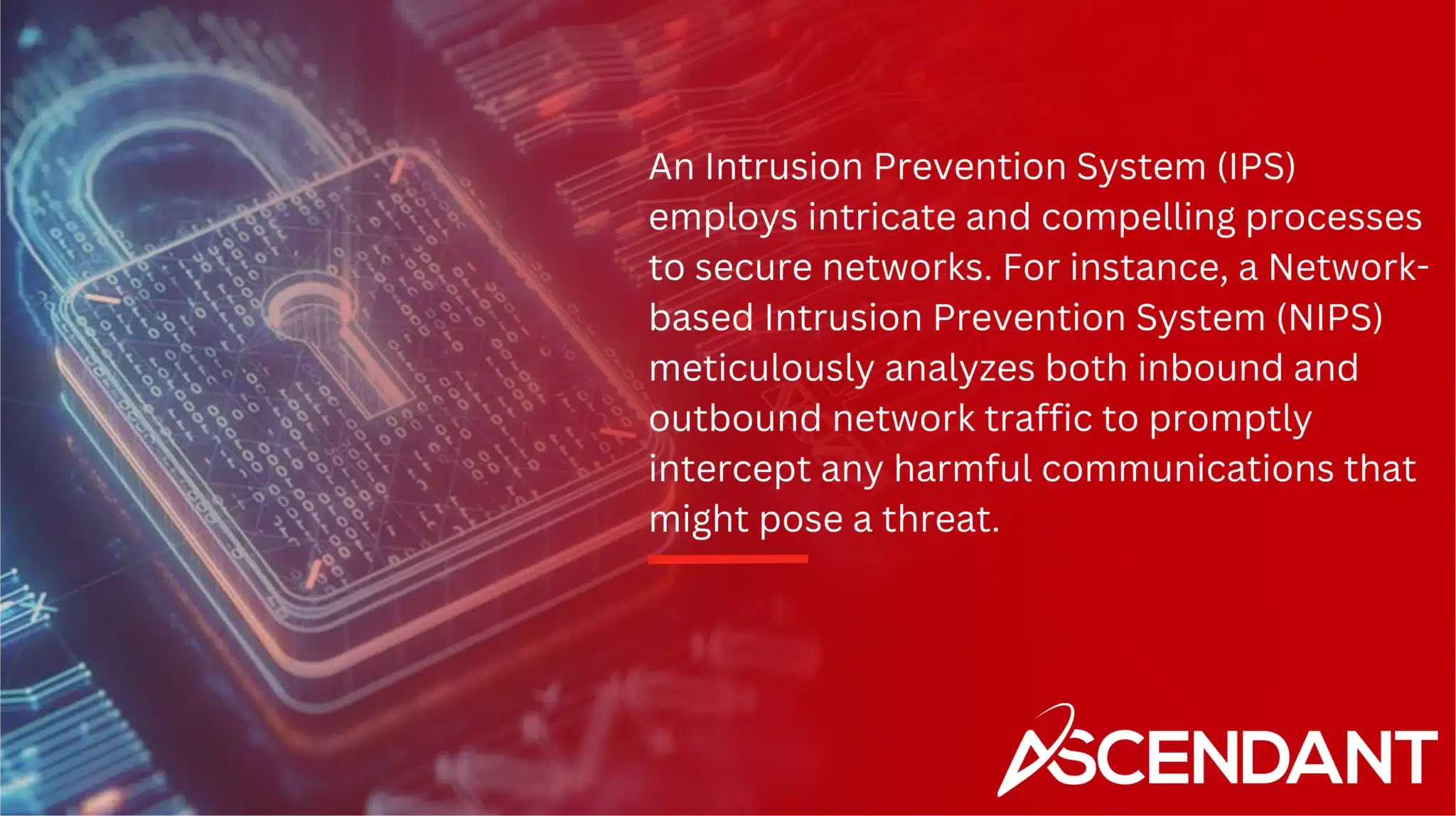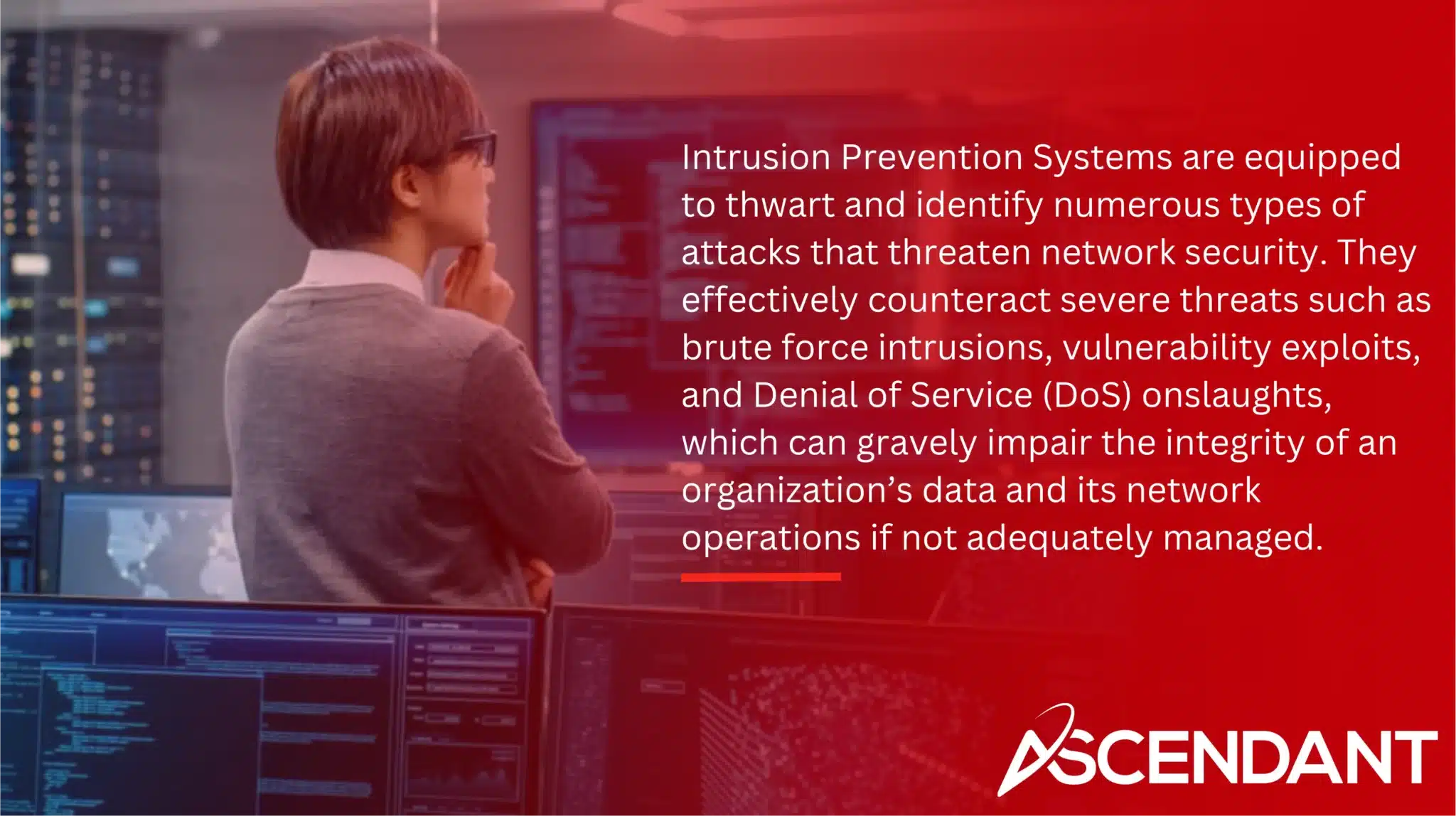An Intrusion Prevention System (IPS) is crucial for network security because it not only identifies but also proactively hinders malevolent actions as they occur, effectively filtering out detrimental traffic to secure your network. This overview will explore the mechanics, varieties, characteristics, and advantages of an IPS to give you a thorough grasp of its significance in protecting against cyber threats.
Key Takeaways
- An Intrusion Prevention System (IPS) actively monitors and prevents malicious activities within a network, differing from Intrusion Detection Systems (IDS) that only alert administrators.
- IPS can be categorized into three types: Network-based (NIPS), Host-based (HIPS), and Wireless (WIPS), each serving specific security needs within different environments.
- The implementation of an IPS offers significant benefits, including automated threat response, enhanced application security, and compliance with regulatory standards, while also mitigating common attacks like brute force and DDoS.
What is an Intrusion Prevention System (IPS)?
An Intrusion Prevention System (IPS) serves as a pivotal component in network security, tasked with the real-time monitoring and thwarting of malicious activities. As opposed to an Intrusion Detection System (IDS), which merely notifies administrators about possible threats, a host intrusion prevention system proactively engages by intercepting and neutralizing harmful traffic before it can impact its target.
Executing primarily inline within the flow of network traffic allows an IPS to scrutinize data on-the-fly, thus equipping it to counteract threats instantaneously. This immediate intervention is essential for curtailing attacks before they inflict considerable harm.
A notable attribute of an IPS lies in its ability to adapt its security policies tailored explicitly for each organization’s unique requirements. Such flexibility guarantees that the intrusion prevention system integrates seamlessly with existing protective strategies of the entity it safeguards, rendering a fortified and adaptable barrier against potential breaches.
How Does an Intrusion Prevention System Work?

An Intrusion Prevention System (IPS) employs intricate and compelling processes to secure networks. For instance, a Network-based Intrusion Prevention System (NIPS) meticulously analyzes both inbound and outbound network traffic to promptly intercept any harmful communications that might pose a threat. The IPS’ vigilant scanning of the digital flow serves as an early alarm system against impending cyber threats.
Situated directly within the data stream, an IPS goes beyond mere identification of malevolent conduct by actively intervening to prevent it from escalating. It carefully examines patterns in traffic and characteristics indicative of attacks, enabling it not just to raise alerts but also undertake decisive measures such as halting malicious traffic or alerting network administrators—substantially enhancing incident management’s timeliness and efficiency.
Once a perilous presence is detected, an IPS swiftly springs into action by precluding access from suspicious sources—in essence acting as a shield—and blocks detrimental ingress before it can pervade your system’s defenses. This ability for instantaneous detection coupled with robust defensive maneuvers distinguishes an IPS significantly from older systems which only serve in detecting anomalies without direct interdiction capabilities.
Types of Intrusion Prevention Systems
Various types of intrusion prevention systems (IPS) are designed to cater to different security requirements and network settings. The main categories encompass Network-based IPS (NIPS), Host-based IPS (HIPS), and Wireless IPS (WIPS).
It is essential to grasp the distinctions among these systems and how they align with particular use cases in order to choose an appropriate IPS for your enterprise.
Network-based Intrusion Prevention System (NIPS)
Intrusion prevention systems deployed within a network are engineered to scrutinize the flow of information at several crucial junctures, thereby guaranteeing all-encompassing network security. In contrast to conventional intrusion detection systems (IDS), which merely identify potential threats, an intrusion prevention system takes proactive measures against such dangers by utilizing both signature and anomaly-based detection techniques.
These systems rigorously monitor ongoing traffic and perform real-time analysis of network behavior to detect abnormal activities or patterns that could indicate a threat. To combat these security risks effectively, a network-based intrusion prevention system can execute automatic actions ranging from obstructing malicious traffic to notifying administrators about possible hazards, thus upholding robust network protection through consistent application of Network Behavior Analysis (NBA).
Host-based Intrusion Prevention System (HIPS)
Intrusion Prevention Systems that are host-based (HIPS) get deployed on separate endpoints, including servers and personal computers. Their monitoring encompasses traffic entering and leaving the system. HIPS zeroes in on safeguarding an individual device through scrutinizing application behaviors to spot potential risks, whereas Network Intrusion Prevention Systems (NIPS) provide surveillance across the entire network.
The strategic position of HIPS is fundamental in thwarting menaces that might have eluded network-level security measures, serving as an additional protective layer. By employing this stratified defensive strategy, organizations can ensure detection and mitigation of threats at the endpoint stage should they penetrate preliminary network barricades.
Wireless Intrusion Prevention System (WIPS)
Intrusion Prevention Systems specialized for wireless networks play a crucial role in preserving network security. They do so by detecting any unauthorized devices that seek to gain entry into the network. With the prevalence of wireless connections today, it has become increasingly vital to protect these networks diligently.
By relentlessly scanning and recognizing any unauthorized devices or actions within a wireless setup, WIPS effectively defends against possible security infractions. This proactive defense helps secure the boundaries of a network by ensuring that only authorized equipment can operate within its confines, maintaining robust protection at all times around the network perimeter.
Key Features of Intrusion Prevention Systems
Intrusion Prevention Systems (IPS) are essential components in the architecture of modern network security, incorporating various detection strategies like signature-based, anomaly-based, and protocol analysis to pinpoint harmful activities. Signature-based approaches match known threat signatures within network traffic using an extensive database.
Conversely, anomaly-based detection scrutinizes select portions of network traffic against a normative baseline to identify deviations indicative of unusual activity or threats – proving especially adept at unearthing novel menaces that elude traditional signature identification methods. This strategy is bolstered by employing techniques such as network behavior analysis, which aids IPS tools in effectively monitoring for anomalies within traffic patterns on networks.
To ensure robust protection, IPS mechanisms must also be equipped with response capabilities including issuing warnings and executing automatic countermeasures like blocking suspect flow or severing connections based on its findings. These systems offer policy-driven detections enabling organizations to enact customized security policies. The system then activates alerts when it detects actions contravening those protocols.
Benefits of Using an Intrusion Prevention System
The incorporation of an Intrusion Prevention System (IPS) into an organization’s defense strategy can significantly bolster its security capabilities. The system automates the response to threats, particularly in environments with high network traffic, increasing operational efficiency. This automation allows IT personnel to shift their focus from routine threat mitigation to tackling more complex security challenges.
An IPS offers a sophisticated level of awareness regarding applications that plays a vital role in securing them. By proactively intercepting and neutralizing threats before they compromise other security devices, it amplifies the protective measures already in place within the digital infrastructure.
Deploying an IPS assists organizations in meeting crucial compliance standards like PCI DSS and HIPAA by aligning with legal and regulatory frameworks essential for conducting business securely. Continuous automatic updates provided by intrusion prevention systems are imperative not only for responding swiftly to emergent threats, but also for ensuring ongoing adherence to these dynamic compliance regulations.
Common Attacks Prevented by IPS

Intrusion Prevention Systems are equipped to thwart and identify numerous types of attacks that threaten network security. They effectively counteract severe threats such as brute force intrusions, vulnerability exploits, and Denial of Service (DoS) onslaughts, which can gravely impair the integrity of an organization’s data and its network operations if not adequately managed.
These systems offer robust defense against Distributed Denial of Service (DDoS) assaults and malicious software infiltration. By scrutinizing for malevolent traffic flows on the fly, Intrusion Prevention Systems suppress advanced penetration attempts with efficiency to maintain the impregnability of network security.
Integrating IPS with Existing Security Infrastructure
Incorporating an Intrusion Prevention System (IPS) into your current security infrastructure is vital for fully leveraging its capabilities. An IPS acts as a supplementary safeguard by identifying and neutralizing threats that may bypass other mechanisms, reinforcing the network’s defense layers. By situating it subsequent to firewalls, the IPS can meticulously scrutinize both incoming and outgoing traffic, delivering extensive protection.
State-of-the-art intrusion prevention systems are designed to integrate smoothly with unified threat management frameworks and advanced firewalls. This fusion not only strengthens the overall defensive stance of your security setup, but also simplifies sharing critical threat intelligence across different platforms within the security landscape.
By effectively embedding an IPS within your suite of protective measures, you amplify the synchronization among various components of your security architecture. As a result, this ensures swift and decisive action against potential threats. An integrated approach employing an IPS in conjunction with other security devices yields comprehensive coverage for securing networks from diverse types of intrusions while overseeing inbound as well as outbound traffic flows.
Recent Trends in Intrusion Prevention Systems
Intrusion Prevention Systems (IPS) are in a state of constant progression, with modern advancements leaning heavily on the integration of cutting-edge technologies such as artificial intelligence and machine learning. By leveraging these innovations, IPS can greatly improve their ability to detect threats by recognizing and reacting to new types of attacks as they happen.
Contemporary IPS solutions increasingly incorporate automated threat intelligence and inline deep learning tools that aid in spotting unfamiliar malicious traffic while maintaining a low rate of false positives. Certain systems make use of honeypots—deliberately placed decoys that mimic valuable data—to both entice and thwart would-be attackers.
Choosing the Right Intrusion Prevention System for Your Needs
Choosing an appropriate intrusion prevention system (IPS) is a pivotal choice that greatly affects the security of your organization’s network. When selecting an IPS, it’s vital to take into account elements such as the system configuration type, its ability to detect various threats, and how well it can be integrated with your existing security infrastructure. These aspects should align with your organizational needs, encompassing both network scale and specific security objectives for optimal effectiveness in choosing an IPS.
A thoughtfully selected IPS will bolster your network’s defense mechanisms by guarding against a diverse array of cyber threats. To ensure you select the most suitable intrusion prevention system for your organization, careful consideration must be given so that it meets all of your particular security requirements.
Summary
To summarize, the role of Intrusion Prevention Systems (IPS) is critical within the realm of contemporary network security. They deliver instantaneous threat detection and mitigation capabilities, along with configurable security policies, ensuring harmonious incorporation into prevailing security frameworks. Understanding of various IPS categories and their distinct advantages enables entities to bolster their defensive strategies effectively.
This primer aims to have imparted substantial knowledge regarding IPS, prompting you to delve deeper into this vital component of network protection. Equipping your organization with an apt IPS ensures that your electronic resources are well-protected against the ever-changing landscape of cyber threats.
Frequently Asked Questions
What is the primary function of an Intrusion Prevention System (IPS)?
An Intrusion Prevention System (IPS) serves to scrutinize network traffic, diligently searching for signs of malicious activity. Upon detection, it takes immediate measures such as intercepting and halting the potentially damaging traffic.
By adopting this forward-leaning strategy, an intrusion prevention system notably bolsters the security of a network.
How does an IPS differ from an IDS?
An Intrusion Prevention System (IPS) actively blocks or drops malicious traffic, in contrast to an Intrusion Detection System (IDS), which merely alerts administrators to potential threats.
Thus, an IPS provides a more proactive defense against intrusions.
What are the key benefits of using an IPS?
An Intrusion Prevention System (IPS) ensures automated responses to threats, bolsters the security of applications, increases efficiency, and eases the burden on IT staff, which helps in meeting regulatory compliance standards.
The advantages offered by an IPS lead to a fortified and more efficient information technology infrastructure.
What types of attacks can an IPS prevent?
An IPS can effectively prevent various types of attacks, such as brute force, DoS, DDoS, and vulnerability exploits. This protection is crucial for maintaining the integrity and availability of network resources.
How can an IPS be integrated into an existing security infrastructure?
An IPS can be effectively integrated into an existing security infrastructure by deploying it inline with network traffic, placing it behind firewalls, and incorporating it into unified threat management systems and next-generation firewalls for improved security.
This integration enhances your overall protection strategy.


